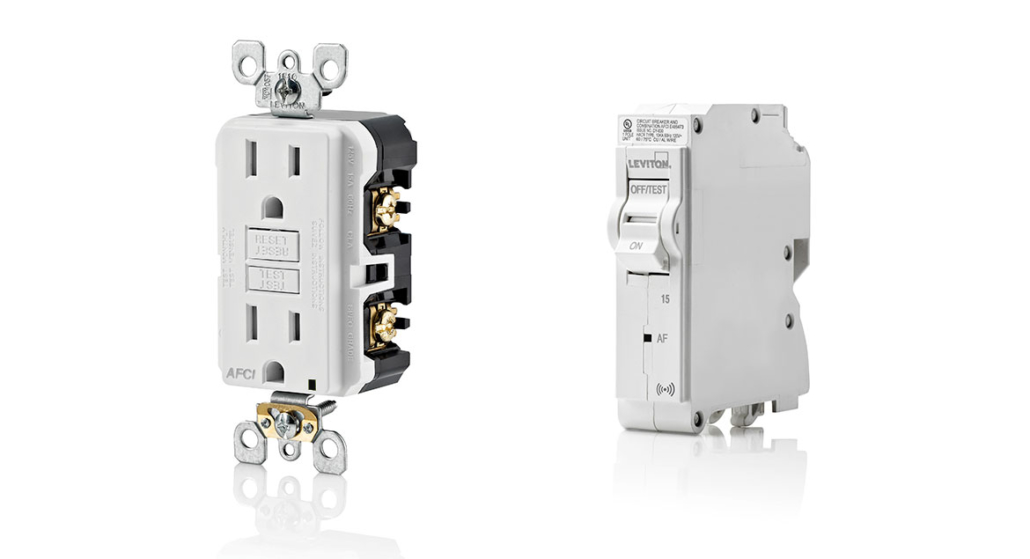The Basics of AFCI Protection: Where is AFCI Required?
Let’s have a little electrical nerd out session on AFCI protection, okay?
They’re important, so stick with us here. We promise to use normal-speak!
RELATED: FLORIDA HOME MAINTENANCE CHECKLIST
What is AFCI Protection?
Arc Fault Circuit Interrupters (AFCI’s) have been required by the National Electric Code (NEC) for certain electrical circuits in homes since 1999.
Originally, they were only required on bedroom outlet receptacle circuits. But over the years, the requirements have evolved to include all circuits in bedrooms and in many other areas of your home.
(NOTE: Your local jurisdiction may not have implemented the most current NEC code yet. They may implement it years later than the NEC releases it. Be sure to check with your local AHJ [Authority Having Jurisdiction] for the most current requirements in your specific area).
This AFCI protection takes the form of either AFCI outlet receptacles or AFCI circuit-breakers. This advanced technology detects “arc-faults,” and hopefully protects against fires resulting from them. They will “trip” the circuit if it detects an arc-fault — much like a circuit breaker or GFCI does.
Older AFCI’s only detected arc-faults on circuits wires in parallel. However, newer versions will also detect them on series circuits. These are known as “Combo AFCI’s,” and are recommended over the older AFCI models. Also, there should not be confused with “Dual-Function AFCI’s,” with protection against BOTH arc-faults, as well as ground-faults like a GFCI does.
An “arc-fault” is basically an unintended electrical current that leaves the wire. If you’ve ever heard the term “arcing-and-sparking,” this is what is going on. If you ever “hear” electricity, that means it is going through the air at some point, and that is also an “arc.”
This is not something you ever want since this can ignite surrounding materials in your home and cause a fire.
The Numbers
An estimated 47,700 home fires reported in 2011 involved electrical failure/malfunction. This resulted in 418 deaths and 1.4 billion in property damage.
This is one of those issues that doesn’t seem like a big deal until it’s too late.
RELATED: CUT ATTIC TRUSSES 101
What Do They Look Like?
Sometimes AFCI protection looks like an outlet with buttons (much like a GFCI, but it IS different), and other times it will be a breaker in the service panel.
They are outlets and circuit-breakers that you probably haven’t paid attention to.
We found a great “cheat sheet” here to help you determine what breaker types may be inside your electric service panel: http://trcsupport.eaton.com/Residential-Distribution/Loadcenters-Resi-Breakers/1010506601/What-is-the-color-scheme-of-the-AFCI-GFCI-and-AFGF-residential-breakers.htm

Where is AFCI Required?
You won’t need to upgrade every circuit, but according to NEC 2020, AFCI’s are required in:
- Bedrooms
- Finished basements
- Kitchens
- Laundry rooms
- Common rooms (such as dens, living rooms & dining rooms)
- Hallways and closets
Often, a normal circuit-breaker can just be replaced with an AFCI breaker by a licensed electrician. We prefer this over changing the outlets.
Also, we don’t usually call it out on older homes as a “defect” needing repair. These are simply newer protective devices, and the cost usually doesn’t justify the safety benefit.
However, if finances permit, they are something to consider adding.
We do occasionally see them missing where required on newer homes. Sometimes they also fail to trip during testing, indicating they should be replaced. In these cases, we will notate them accordingly as a defect in our reporting.
RELATED: WHAT TO EXPECT FROM YOUR HOME INSPECTION – BEFORE, DURING & AFTER
How Do I Install an AFCI?
Unless you have extensive electrical experience, we recommend you find a qualified electrician to handle this job. Some older circuitry configurations can also cause nuisance tripping of the AFCI. So it really should be evaluated by the electrician first.
What is the Difference Between AFCI and GFCI?
GFCI’s are to protect you from electrical shock. This can happen if an appliance or tool you’re using becomes energized due to a ground-fault. A ground fault could be dropping a plugged-in hairdryer, radio, or toaster into a sink, or holiday lights in a puddle of water.
AFCI’s are to protect against electrical fire resulting from an arc-fault. Again, the arc-fault is the electricity that leaves the wire and goes through the air or other nearby material.
What do I need to do now?
Maybe nothing.
If they weren’t required when your home was built, this is not necessarily an issue. It depends on the rules set out by your AHJ. It’s a good idea to add them if finances permit.
If you do have AFCI outlets or breakers in your home, test them (using the test button) when you also test your smoke-detector alarms.
We recommend doing so monthly. If they fail to trip, have them further inspected (and likely replaced) by a qualified electrician.
If you don’t have them but want to add AFCI protection to your home, contact a qualified electrician. Arc-faults usually happen around loose connections or damaged wire sheathing.
This can be common in older homes, especially those with cloth wiring or a history of rodents in the attic or crawlspace. It’s always a great idea to add it (even if these factors aren’t present), but it should only be done by a professional qualified electrician.
NEXT: IS YOUR HOME FIRE SAFE?






